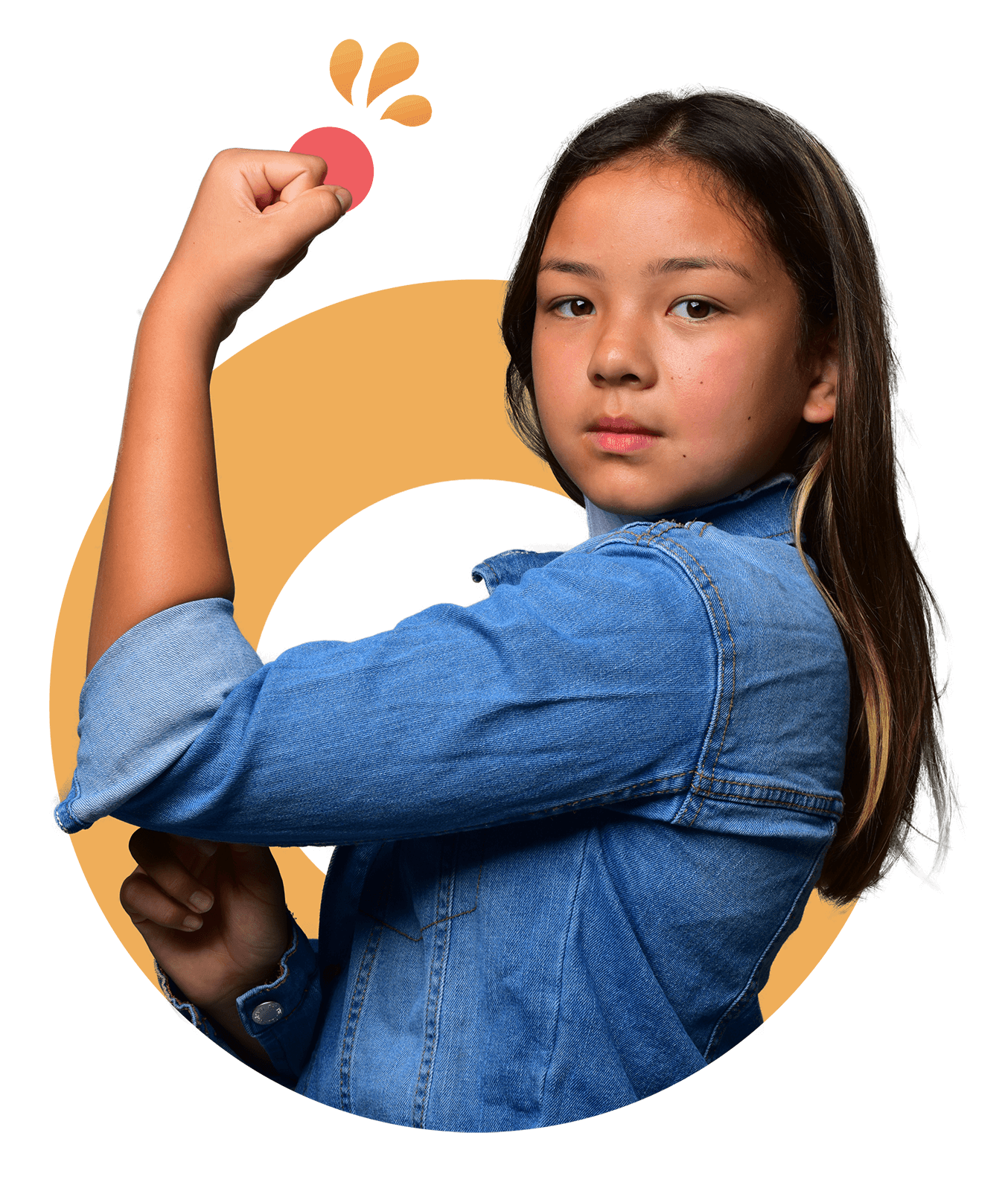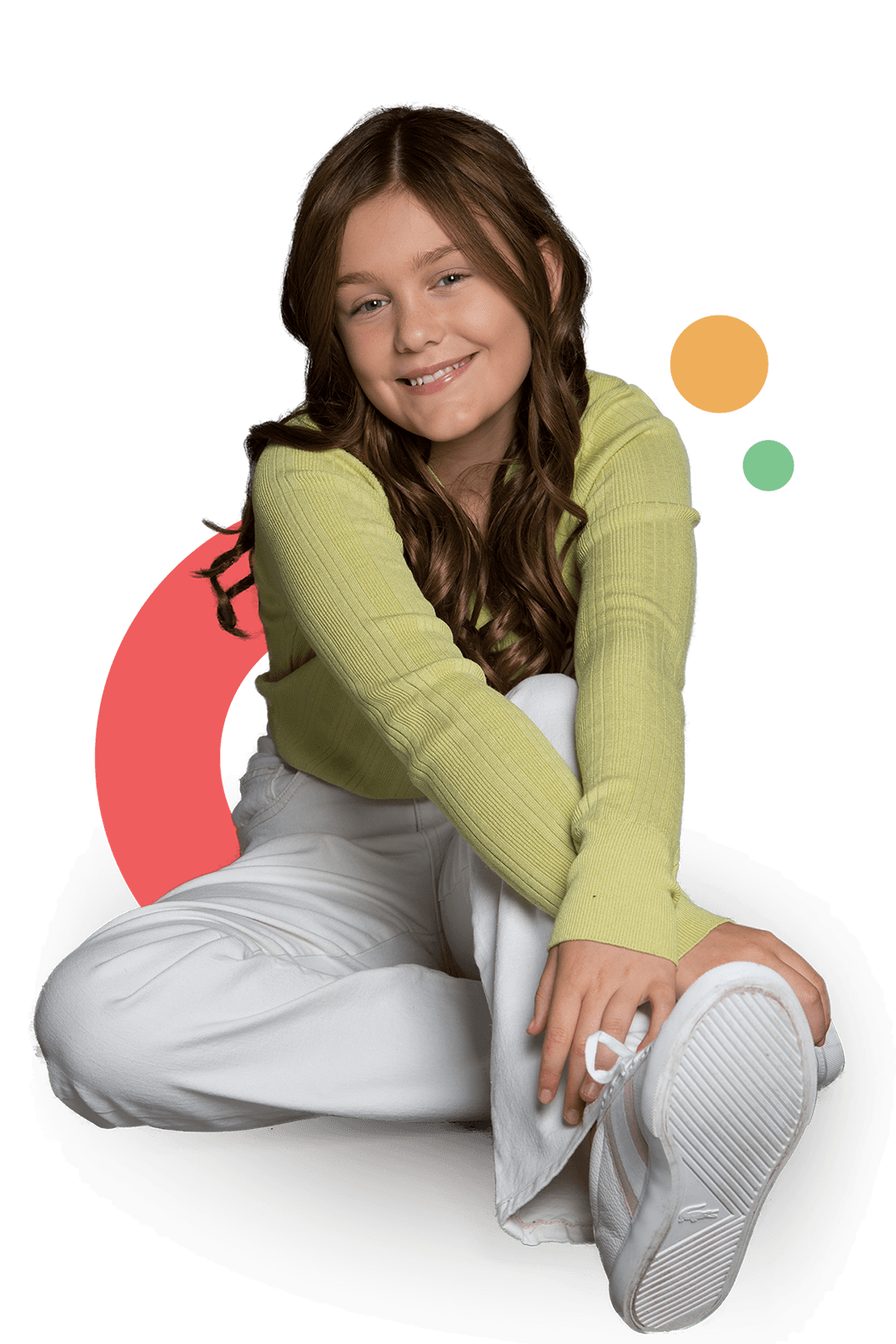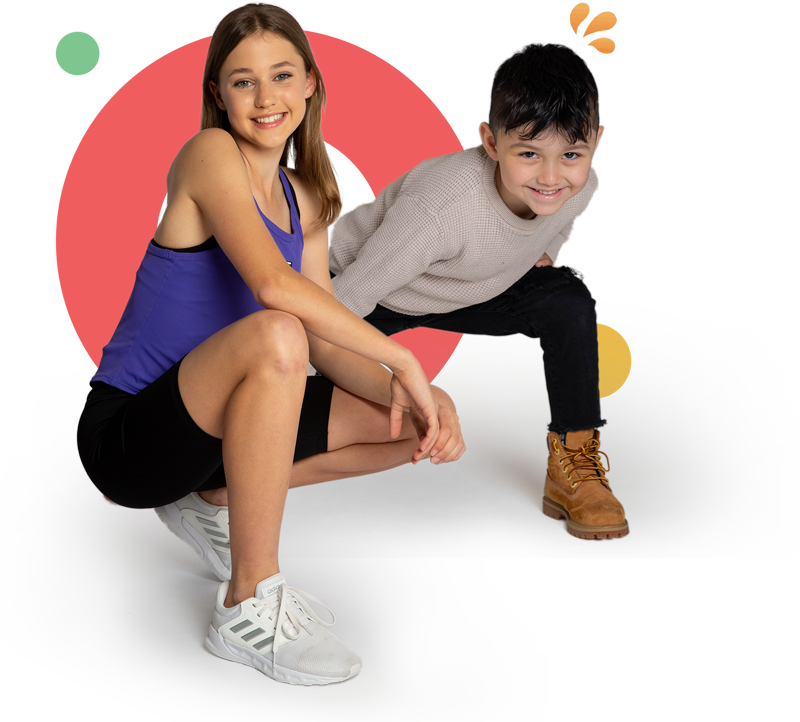- As Featured on:

Getting through the tricky and often frustrating audition process is no mean feat. If your child or teen manages to impress and is lucky enough to land the role, then it’s certainly time to celebrate. After all, they’ve put in so much hard work and effort to get this far so credit where it’s due!
But there’s not much time to rest on your laurels because the real work is just about to start. From memorising lines to understanding the plot and storyline of the production — there’s so much to do. And perhaps one of the most difficult first steps that your budding little star will need to take is learning how to get into character.
This is one of the most important aspects of acting and perfecting this particular skill will pretty much guarantee that your child or teen can deliver a believable performance that any director will be proud of.
So yeah, it’s kind of a big deal.
Luckily for you, the team here at Bubblegum HQ have decades of experience helping some of Australia’s most successful child and teen actors prepare for their big breaks. And we’ve drawn on that experience to bring you an ‘all you need to know’ guide on getting into character.
The process and tips we share below are tried and tested methods that the Bubblegum kids have used in the past with great success. But just remember, it’s not enough to simply read the guide, you and your child will need to put in some good old fashioned hard work to make it work.
But we know you can do it!
So let’s get started.
How to Read and
Understand a Script

First up we have the very simple first step of reading the script. Now, you might laugh at the idea that we need to explain this step, but this is no story book or novel for young adults. Scripts are written in such a way that some kids may find it difficult to understand. This is where your skills as chief bedtime story reader come in handy.
Now, you may not get your hands on the full script and that’s okay. Some directors prefer to give a child actor the script for their scene alone particularly if they only appear in one scene. Your agent will usually be the one to handle any communications between you and the production crew so feel free to ask if they can get you a synopsis of the script so you can give your child a general idea of the storyline.
If the role is for an existing TV show, you and your child can watch a few episodes to get a feel for the other main characters in the show. If it’s a movie-version of a stage production or a remake of an older movie, just watch the older version and keep an eye out for your child’s character.
However, kids or teens who appear throughout the production will certainly receive a full script. If that’s the case, now’s the time to get reading!


The First Read
Before you get started, we’ll just note that there is no need to get bogged down during the first read. This is just a chance for you and your child to get a feeling of the storyline and understand the plot and characters involved.
During this stage, it’s a good idea to highlight the scenes and events which will have an effect on your child’s character. For example, if there’s a scene that your child doesn’t appear in but a family pet goes missing, that’s certainly something that could affect your child’s character.
If your child is quite young or the script is a little heavy, you may want to go through this first read by yourself. That way, when you introduce the story to your child, you’ll already know the key scenes to highlight and the general storyline.
Older teens might prefer to have a go at the first read by themselves and that’s fine. But if that’s the case, we recommend that you both have a read separately and then come back and compare notes with each other.
Just remember that while it is certainly important to read the entire script, there is no need for you (or your teen if they’re reading alone) to spend too much time trying to understand the intricacies of the story just yet. A general understanding is what you’re after here and some background that can help give you an insight into your child or teen’s character.

Section off the Scenes
Every script you’ll ever read is written as a series of events leading from point A to B, C, and so on until the story reaches its conclusion. It’s pretty simple when you think about it, right?
Now, what you need to do is break the story up into groups of scenes as this will help you understand the flow of the story. For example, scenes 1 through 3 might be all related to a certain event. You can mark those as one section or even a ‘chapter’ of the overall story.
Doing this will help you map out the overall story and quickly highlight the points that are relevant to your child’s character.
Sounds like a lot of work so far, right? But trust us, once you have done this for the first time, it will become much easier for future roles.

Now Break Down the Relevant Scenes
You should have already highlighted those important scenes that affect your child’s character and now it’s time to have a really close look at them.
Sometimes these scenes can be broken down into what are called beats. Beats are smaller shifts within a scene where things might change. This could be a character’s mood, the introduction of a plot twist, or a new character entering the scene.
All of these beats are important as they will have an effect on your child’s character. For example, if the scene is interrupted by a doorbell or an unexpected event of any kind, your child will have to adapt and change their mood or behaviour accordingly.
It’s a good idea to take a few notes here at this point especially if there are quite a lot of scenes to go through.
Identify Your Character’s Actions
This is where a script differs from reading your average children’s book. A script will give your child specific instructions on their character’s movements and actions. It might be tempting to ignore these for now as the director will no doubt give your child instructions on the set, but that’s not the greatest approach to take.
It’s better to take a look at them now and explain to your child the various actions they might be expected to take. It’s surprising just how much this can help younger kids in particular understand scenes a little better. It also gives them small physical cues that will help them remember their lines once they start acting on set.
Ask Questions
This is a fun little activity that will help the reading time go a little quicker and keep your child amused and thinking along the right lines.
Whenever you hit a point where your child’s character is involved in a scene, ask some questions.
- What does their character want other people in the scene to do?
- What’s their character’s mood at this point?
- What kind of body language would suit this mood?
Then you can ask some deeper questions.
- What’s the character’s backstory?
- Why do they act the way they do?
Even if you have yet to explain the full story or read it to your child, you’d be surprised at how insightful young minds can be when asked questions like these. This is also a great way for your child to remember things about their character as a child rarely forgets something that they have thought of themselves.



Make it Relatable
Now, this is another little exercise that can be a fun one to try out. Children won’t always be able to relate to the things that are happening in their scenes or their character’s backstory. This is particularly true if there are aliens or robots involved 🙂
So when discussing their character’s actions, emotions, and backstory, it might be a good idea to use analogies that your child can relate to. If the character is upset because they have lost their magic powers (it could happen to anyone!) then perhaps ask your child how they would feel if they suddenly were no longer able to swim or ride a bike.
Sometimes these types of analogies can work wonders for helping a child to understand the depth of a character’s emotions.
When in Doubt, Reach Out
If there’s anything that you genuinely don’t understand about the script or your child’s role in their scenes, there’s no harm in reaching out to the production crew with a few questions. Now, they are extremely busy, so you have to be absolutely sure that you really need help. For example, if your child only has a few lines in one scene, then it may not be necessary to ask ahead of shooting time.
However, for those lucky enough to be in multiple scenes, asking questions or requesting some guidance is perfectly acceptable. In fact, it shows the director that your child is taking their part seriously. Just be careful not to overdo it as there is such a thing as too many questions!

Doing Your Research

Now that you have read your script and had some fun discussing your child’s character and the reasons behind their actions, it’s time to go a little deeper and see if your ideas were on the right track.
For well-known characters that have appeared in previous versions of a production, this part can be quite simple. As we mentioned earlier, all you need to do is rewatch some old movies or episodes of a TV show. While no two portrayals of a character are exactly the same, you’ll certainly find enough common elements to give you a good idea of what the director may want. Think Charlie Bucket from the two Hollywood versions of Charlie and the Chocolate Factory and you’ll see what we mean.
Once again, it’s time to get the pen and paper out and start making some notes. Get your child involved in this step as it can be quite fun.
You’ll want to make a list of the following aspects of your child’s character, but remember that if you can’t find these details out alone, it’s okay to ask your agent if they can pass along your questions to the production crew or the casting director.

Physical Attributes
Of course, this may not affect how your child plays their character, but it is certainly a fun way to keep your child interested in their character. We’re talking height, hair colour, facial features, and anything else that might make the character unique.
Personality Profile
What kind of temperament does your child’s character have? Are they mild-mannered and polite or are they boisterous and perhaps even a little out of control or, dare we say it, naughty!
And we’re not necessarily talking about their mood in the scene but their overall personality throughout the story. So while your child may have to act angry or nervous in one scene, that may not be how the character is portrayed throughout the script.
This is a question that you can ask the director or screenwriter, if you are having trouble figuring it out for yourself.


Create a Character Questionnaire
This is a set of questions that can help you understand a character more or help you develop the personality of a character. Now, usually this is something that a screenwriter will use to develop a character. However, you and your child can also use a simple character questionnaire.
Think of it as a ‘what if?’ game where you ask your child what would the character do if this or that happened. We’ve done this before in Bubblegum HQ with some of our kids and it’s a surprisingly fun exercise that allows your child to really take on their character’s role.
Try to steer the questions towards answers that would give an insight into the character’s personality and let your child provide their own thoughts. Like we said earlier, you’ll be surprised at just how deep a child can be when asked the right questions.
How to Prepare and
Rehearse Like a Pro
If you know the Bubblegum team then you know that practice makes perfect is our mantra. It’s a belief that we try to instil in all of the Bubblegum kids especially when it comes to auditions. After all, they attend so many!
But learning how to act and get into character isn’t just about practice but also the preparation that you put in before you start acting. In fact, have you ever heard the saying ‘acting is 90% preparation and 10% perspiration’? Well, it’s absolutely true!

Manage Your Time Wisely
When it comes to reading through scenes or practising lines, we find that it always helps a child if you have a set schedule. With this in mind, it’s a good idea to set aside blocks of time for practice at least twice a day. How long these blocks of time are will depend on your child’s age, how many scenes they appear in, and most importantly, how long they can pay attention for.
The last thing you want to do is bore your child, so if they tire easily or lose interest quickly, it might be better to practise for shorter periods but to do so more often throughout the day.
It’s also a good idea to arrive early to any reading, rehearsal or shoot. And we don’t mean five minutes early. If you can, we suggest getting there a good 15-20 minutes early so you and your child can have some time to run through a few lines and get in the right frame of mind.
This also has the added bonus of making your child look like the consummate professional who arrives early and takes their work seriously 🙂




Practice Out Loud
Your child should always and we mean ALWAYS read their lines out loud. This will allow them to get comfortable with the way the words sound as they say them and help with their overall enunciation. Not only that but it will also help them to get into character as it’s much easier to display and feel an emotion if you are saying something out loud as opposed to reading or reciting it quietly in your head.
One word of warning here — we wouldn’t advise doing this in an audition waiting room as there will be other kids there who are also trying to prepare.
Research Other Aspects of the Script

Try a Little Immersion
We’re sure you’ve heard all kinds of crazy stories about actors who have totally immersed themselves in a character to prepare for a role. Some even go so far as to ask their family members to only address them as their character for the duration of the filming of the production!
We’re not for a moment suggesting that you go that far. However, it would be a good idea to try it out for short periods of time. You could decide that for a specific part of the day, say breakfast or dinnertime, your child must stay in character and you must address them by their character’s name. You can even take it a step further by taking on one of the roles in the script yourself at the same time.
This can be a really fun way to let your child get comfortable with acting as their character and knowing how to switch it on and off. If they can master this before you get on set, the director will certainly be impressed.

Taking Advantage of
Role Playing Skills
We don’t need to tell you just how important hair, makeup and wardrobe is for the actual production, but it can be just as important for rehearsal and getting into character too.
Think about it this way — when your child dresses up as a knight or a police officer, you can instantly see the slight changes they make to better fit the role. They might make their voice deeper or change the way they walk or move. This is simple role playing and you can really take advantage of this natural skill that all children, and we really mean all children, possess.
The best way to tap into this natural ability is to introduce some form of prop or a costume. This could be a simple pair of glasses with clear lenses or a shirt and tie. It could even be a matter of styling their hair in a certain way. Whatever it is, it must be relevant to the part that your child is playing.
Once they have their prop in hand or their costume/wardrobe change, they’ll automatically slip into what they feel their character is. Then it’s up to you to guide them along with a few tweaks here and there.
While this can be an incredibly helpful little trick to get your child into character, you don’t want them to become too reliant on the prop or costume.
So try not to use this tip every time you rehearse or practise lines. Instead make it a special ‘dress rehearsal’ that you do every now and then.


How to Look and Feel Natural
One of the most difficult challenges a professional actor will face is trying to look and feel natural when on camera. So you can imagine how difficult this is for children who are being told to emphasise an emotion or character trait.
Yep, finding that perfect balance can be quite the task, so here are a few tips that should help.


Let Yourself Loose
It’s surprising just how much loosening up your body can help with acting. We see it all the time with new actors who have not gone through a warm up or loosening up routine and end up looking stiff and uncomfortable when on set.
So try to set up a little routine that you can run through with your child or teen. It could be a simple matter of flapping arms or stretching out. It could be deep breathing exercises or some kind of mediation. It could even be the simple act of repeating a rhyme or tongue twister to help warm up your child’s voice. Whatever you choose to do, make it a routine and it will help your child slip into acting mode without even realising it! And that’s the key — when it comes naturally, they will act naturally.
Practice. Practice. Practice.
We’ve said it before and we’ll say it again — nothing beats practice. The more a child becomes familiar with a role and the lines of a scene the less likely they are to overact without realising it.
Memorising lines, working your way through scenes with them, getting in character at the breakfast table — these are all forms of practice and the more often you do them, the more natural your child will feel.
But, and it’s a big but… don’t push your child too hard. If you have set your practice times for the day, stick to them. If you push too hard, you run the risk of your child feeling jaded and just going through the motions to get the job done. And that’s the last thing you want to happen.

Master Those Emotions
In acting, emotions are everything. So as you can imagine, it’s super important that your child has a good handle on their emotions and knows how to put them on display in the most natural way possible. This one can be really tough, especially when we’re talking about emotions such as sadness or regret.
The best actors will try to feel the emotion on a genuine level. Easy enough with happiness or excitement, but like we said, tough when it’s a sadder emotion. This is where your analogies that you used earlier will come in handy once again. It’s good to have one for each emotion and have your child try to convince themselves that this analogy is real just for the short time that they want to feel that emotion.
Teens should have no trouble with acting with emotion, but younger kids will need a lot of help from their parents to master this one.
What About Classes?

All of that seems like a lot of hard work and you’re right, it is. But trust us — once you get through that first role, your child will understand the process and take to it like the proverbial duck to water.That said, we know that not all parents will feel comfortable guiding their child through this step of the process. And we totally understand, after all, it’s completely new to you too, right?
That’s where acting classes can come in handy and it’s one of the reasons why we set up Bubblegum Academy. We wanted to create an affordable and convenient way for parents to give their children a headstart in the world of acting. It’s an online learning platform with a wide variety of acting classes and workshops for actors of all ages. And yes, we even have lessons in acting with emotion and getting into character. We’re not going to go into too much detail here, so if you want to learn more you can visit Bubblegum Academy. Trust us though, if you’re stuck for time or struggling with the tips above, joining the academy could be just what your child needs.

